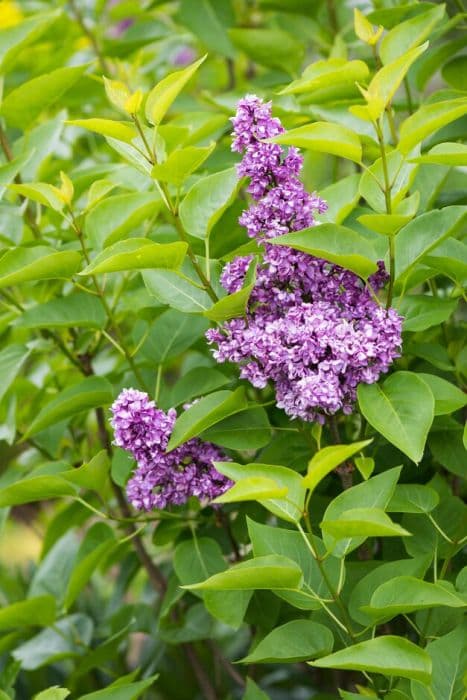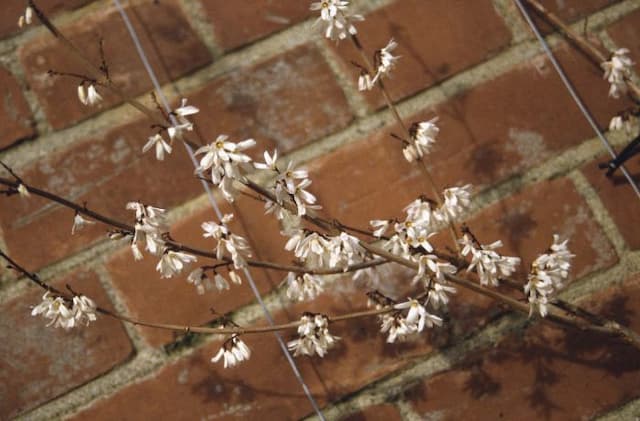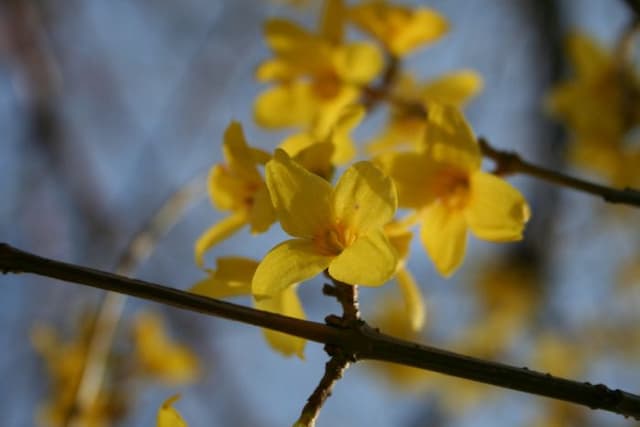Common lilac Syringa vulgaris 'Charles Joly' (d)

ABOUT
The Charles Joly lilac is a cultivar renowned for its stunning flowers and delightful fragrance. This plant is notable for its lush, heart-shaped leaves that present a deep green hue and provide a dense, leafy backdrop to its floral display. The foliage itself can create a lush visual texture in gardens. The flowers appear in large clusters called panicles, which are densely packed with individual blossoms. These blooms are a striking deep purple with a magenta hue, and each flower consists of four petals that form a tubular base with a flared, open end, giving them a classical lilac shape. When the plant is in full bloom, these opulent panicles create a dramatic and vivid display that is both visually and aromatically appealing. The blossoms are highly prized for their intense fragrance that can pervade the entire surrounding area. The Charles Joly lilac’s sturdy stems support the weight of the blooms well, and the plant retains a bushy, somewhat rounded shape that adds to its ornamental value. The overall impression of the Charles Joly lilac is one of robust beauty and sensory delight, making it a cherished addition to gardens where a showy splash of color and scent is desired.
About this plant
 Names
NamesFamily
Oleaceae
Synonyms
Common Lilac, French Lilac
Common names
Syringa vulgaris 'Charles Joly'
 Toxicity
ToxicityTo humans
The common lilac is not considered highly toxic to humans. Ingestion of parts of the plant, especially in large quantities, might cause gastrointestinal symptoms such as abdominal pain, vomiting, or diarrhea. If symptoms occur, medical attention is advised.
To pets
Common lilac is generally recognized as safe for pets, with no significant toxic effects reported. However, ingestion of large amounts of the plant can potentially cause mild gastrointestinal upset in some animals. Symptoms could include vomiting or diarrhea. If any severe symptoms are observed after a pet ingests any part of the plant, it's recommended to contact a veterinarian.
 Characteristics
CharacteristicsLife cycle
Perennials
Foliage type
Deciduous
Color of leaves
Green
Flower color
Purple
Height
10 feet 3-4 meters
Spread
8 feet 2-3 meters
Plant type
Shrub
Hardiness zones
3-7
Native area
Balkans
Benefits
 General Benefits
General Benefits- Aesthetic Appeal: Syringa vulgaris 'Charles Joly', commonly known as the lilac, has beautiful deep purple flowers that add vibrant color and visual interest to any garden or landscape.
- Fragrance: Lilacs are well-known for their delightful fragrance, which can infuse an area with a sweet and inviting scent during their blooming season.
- Wildlife Attraction: Lilacs can attract butterflies, bees, and other beneficial pollinators, promoting biodiversity and contributing to the health of the local ecosystem.
- Shade and Shelter: As a deciduous shrub, lilacs can provide shade and shelter for smaller plants and garden wildlife during the warmer months.
- Privacy Screening: When planted in a row or as a hedge, lilacs can provide a natural privacy screen, creating a living wall that separates different areas of a landscape.
- Windbreak: Lilacs can serve as a windbreak, reducing wind speed and protecting more delicate plants in the garden from harsh weather conditions.
 Medical Properties
Medical PropertiesThis plant is not used for medical purposes.
 Air-purifying Qualities
Air-purifying QualitiesThis plant is not specifically known for air purifying qualities.
 Other Uses
Other Uses- Lilac wood is dense and can be used to create small objects such as knife handles or jewelry. The wood of Syringa vulgaris 'Charles Joly' can also be utilized for these purposes.
- As a natural dye, the flowers of Syringa vulgaris 'Charles Joly' can be used in textile coloring, imparting a light green hue when used in the dyeing process.
- The strong fragrance of lilacs is excellent for homemade potpourri; dried 'Charles Joly' flowers will retain their scent for a long time, effectively freshening up drawers and closets.
- In the art of bonsai, lilacs like Syringa vulgaris 'Charles Joly' can be trained into miniature tree forms, showcasing their beautiful blooms at a smaller scale.
- Lilac flowers can be pressed and included in crafts such as handmade paper or floral resin jewelry, where they add color and delicate botanical elements.
- The blossoms of Syringa vulgaris 'Charles Joly' can be infused into syrups, imparting a floral note to desserts, cocktails, or sodas.
- As a natural air freshener, the aromatic compounds in lilac blossoms can be extracted and used in homemade sprays or diffuser blends.
- In landscape design, 'Charles Joly' can be used to create a living fence or privacy screen, with the added benefit of a beautiful bloom display each spring.
- Lilacs can be used in floral arrangements not just for their beauty but also for their structure, as the sturdy stems can support other, more delicate flowers.
- Artists sometimes use the blooming branches of Syringa vulgaris 'Charles Joly' as subjects for botanical illustration or as inspiration for color palettes in various forms of artwork.
Interesting Facts
 Feng Shui
Feng ShuiThe Lilac is not used in Feng Shui practice.
 Zodiac Sign Compitability
Zodiac Sign CompitabilityThe Lilac is not used in astrology practice.
 Plant Symbolism
Plant Symbolism- Love: Commonly known as Lilac, the Charles Joly variety of Syringa vulgaris symbolizes first love and youthful innocence, with its sweetly scented blooms often reminiscent of an early romance.
- Renewal and Fresh Beginnings: Lilacs mark the coming of spring and therefore are emblematic of renewal and new beginnings.
- Nostalgia and Remembrance: The intoxicating fragrance and the transient blooming period evoke a sense of nostalgia and remembrance.
- Spirituality: In some cultures, lilacs are seen as a symbol of spirituality due to their serene appearance and scent.
- Confidence: The lilac's robust nature and regal purple blooms are often associated with confidence and the ability to make decisions.
 Water
WaterLilacs, including the 'Charles Joly' variety, prefer even moisture and should be watered once a week, providing about one inch of water each time. However, during hot or dry spells, you may need to water twice a week. Ensure that you water deeply to encourage root growth, which means slowly watering around the base of the plant to reach at least 18 inches into the soil. Avoid overhead watering to prevent disease and water early in the morning to minimize evaporation. Mature plants typically need a total of 1.5 to 2 gallons of water per week.
 Light
Light'Charles Joly' lilacs thrive in full sun, requiring at least six hours of direct sunlight each day to bloom well. They can tolerate partial shade, but flowering may be reduced. The best spot for your lilac is in an area that receives unfiltered sunlight for the majority of the day, preferably morning through afternoon sun.
 Temperature
TemperatureLilacs, including the 'Charles Joly' variety, are hardy and can withstand winter temperatures as low as -30°F and summer temperatures up to 95°F. The ideal growing temperature for lilacs is between 60°F and 75°F during the growing season. They require a period of winter chill to ensure prolific blooms in the spring.
 Pruning
Pruning'Charles Joly' lilacs should be pruned immediately after blooming to shape the plant or to remove dead or weak branches. Pruning just after the flowers have faded allows time for the plant to set buds for the next year. Cut back no more than one third of the branches, focusing on removing old wood, which encourages the growth of fresh, blooming stems.
 Cleaning
CleaningAs needed
 Soil
SoilThe best soil mix for the common lilac (Syringa vulgaris 'Charles Joly') is well-draining, fertile, and loamy with a pH of around 6.5 to 7. To create this, blend garden soil with compost and a small amount of perlite or sand to improve drainage.
 Repotting
RepottingCommon lilacs such as the Syringa vulgaris 'Charles Joly' are typically grown outdoors and do not need repotting. They are usually planted in the ground where they can grow without the need for repotting.
 Humidity & Misting
Humidity & MistingThe common lilac (Syringa vulgaris 'Charles Joly') thrives best in average outdoor humidity levels. It does not require high humidity and can tolerate the conditions found in most temperate climates.
 Suitable locations
Suitable locationsIndoor
Provide sunlight, cool temps, and regular pruning for common lilacs indoors.
Outdoor
Plant in full sun, well-drained soil, and water regularly.
Hardiness zone
3-7 USDA
 Life cycle
Life cycleThe life of a common lilac (Syringa vulgaris 'Charles Joly') begins with seed germination, which typically requires stratification to simulate winter conditions and encourage sprouting. After germination, the seedling stage takes place, where the plant develops its initial root system and first true leaves. The sapling stage follows, during which the plant grows rapidly, establishing a more robust root system and fuller foliage. As the lilac reaches maturity, it enters the flowering stage, usually in the spring, producing fragrant, purple flowers and attracting pollinators. After pollination, the flowers develop into brown capsules that release seeds when mature, completing the reproductive cycle. The plant then enters a period of dormancy in the winter before the cycle begins anew with the next growing season.
 Propogation
PropogationPropogation time
Spring
The common lilac, specifically the 'Charles Joly' variety, is most popularly propagated through softwood cuttings. This method often takes place in late spring or early summer, when the plant's new growth is just beginning to harden yet still flexible, typically May to June depending on the local climate. When propagating, a gardener selects a healthy, non-flowering shoot and cuts a 4 to 6-inch (approximately 10 to 15 centimeters) length. The bottom leaves of the cutting are removed and the cut end might be dipped in rooting hormone to encourage root development. Then, the cutting is placed in a well-draining soil mix, ensuring that several nodes where the leaves were removed are buried as these locations are where roots are most likely to form. The pot with the cutting is kept moist and in a warm area with indirect light until roots have established, which can be verified by gentle tugging on the plant after a few weeks.

![Forsythia [Marée d'Or]](/_next/image?url=https%3A%2F%2Fplants-admin.emdemapps.com%2Fimages%2Fplants%2F%2Fimages%2F604b5d7568293.png&w=640&q=75)







